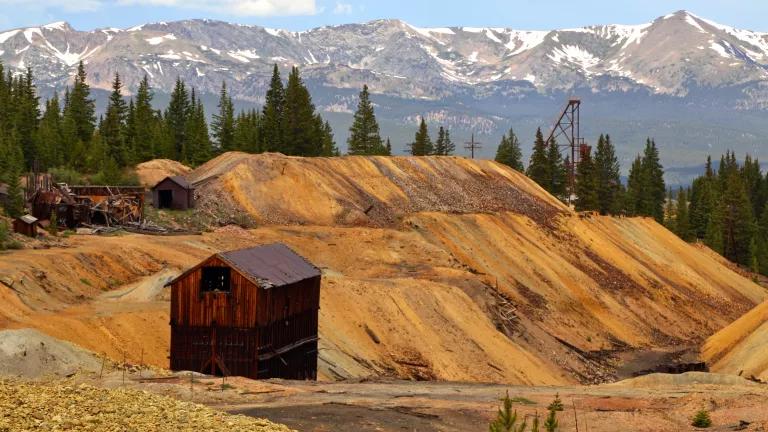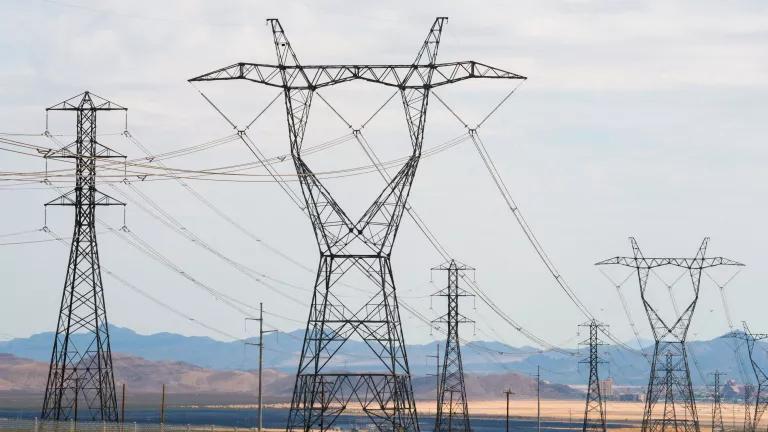Western Energy News Round-Up: Solar and Wind Energy Potential Touted, Large CSP Projects Come Online, Investment and Impacts of Coal Export Terminals Criticized, and Gas Flare Waste from Fracking Exposed
Western Energy News Round-Up is a weekly selection of news highlighting recent energy and environmental issues in the western United States.
August 1 – 7, 2013
Renewable Energy:
U.S. wind power fastest-growing energy source in 2012, report says
In a first, wind energy became the No. 1 source of new U.S. electricity generation capacity in 2012, according to a report released by the Energy Department on Tuesday. Wind energy accounted for 43% of new electric additions last year, adding more than 13 gigawatts of new wind power capacity to the U.S. grid - double the capacity installed the year before. At the same time, wine power is at an all-time low price. But Energy Department officials warn that future growth is uncertain and they are urging an extension of production tax credits that have helped spur wind energy production and manufacturing. The economic benefits of wind energy are explored in depth here.
(LA Times, August 6, 2013)
Solar energy could supply one-third of power in U.S. West
Low-cost solar power could supply more than a third of all energy needs in the Western U.S., if the nation can hit its targets for reducing the cost of solar energy, according to a new study by researchers at the University of California, Berkeley. The UC Berkeley scientists used a detailed computer model they developed of the West’s electric power grid to predict what will happen if the U.S. Department of Energy (DOE) succeeds with its SunShot Initiative, which aims to make solar power more affordable and accessible to Americans. They found that achieving the SunShot target would allow solar photovoltaic technology to provide more than a third of electric power in the region by 2050, displacing natural gas, nuclear and carbon capture and sequestration technologies. This would reduce greenhouse gas emissions enough to help minimize the negative impacts of climate change, the researchers said.
(UC Berkeley News Center, August 1, 2013)
Massive CSP projects finally coming online in AZ, CA
At least two of the world’s largest concentrating solar power (CSP) projects, also known as solar thermal projects, are set to come online in August, according to recent reports. Both the Ivanpah Solar Electric Generating System (SEGS) in California and the Solana Generating Station in Arizona are set to start delivering power next month, which is a big milestone for CSP technologies in the U.S. and could help foster future generations of the technologies. The Solana Generating Station by Abengoa Solar in Gila Bend, Ariz., is a 280 megawatt parabolic trough system that concentrates sunlight on liquid-filled tubes to power a steam generator and provide heat for thermal. The BrightSource, NRG and Google Ivanpah SEGS being built by Bechtel is a 377 megawatt solar tower CSP system that consists of three tower systems.
(Clean Energy Authority, July 31, 2013)
Guest column: Montana needs fair access to renewable energy markets
Earlier this month, NorthWestern Energy officially dedicated its new 40-megawatt wind farm, Spion Kop, near Great Falls. Energy from the wind farm will cost approximately $54 per megawatt-hour, nearly $10 per megawatt-hour cheaper than NorthWestern’s Colstrip coal energy. Today Montana exports nearly half of all the electricity it produces. Most of the exported energy comes from coal plants. But coal’s contribution to the electric grid is facing new scrutiny as we are forced to confront climate change. Montana must actively replace coal exports with new renewable energy or will lose the broad economic benefits from energy production.
(Bozeman Daily Chronicle, August 5, 2013)
Fossil Fuels:
Goldman Sachs says coal-export terminals are a bad investment
Given flat demand for electricity, cheap natural gas, burgeoning renewables, rising efficiency, and future carbon regulations, new coal-fired power plants are bad bet, which is why they aren’t getting built. Demand for coal in China is a crucial justification for the export infrastructure coal companies want to build in the Pacific Northwest — export terminals in Oregon and Washington that would handle coal shipped by train from the Powder River Basin in Wyoming and Montana. But overseas demand for thermal coal — the kind used in power plants — has been overestimated. Goldman Sachs forecasts that there will not be enough global demand to justify even the large-scale coal exploitation projects already in the pipeline.
(Grist, July 29, 2013)
Ecological impacts, climate effects to be weighed in review of Wash. coal export terminal
The largest of three proposed coal export terminals in the Northwest -- the Gateway Pacific Terminal, near Cherry Point, Wash. -- will undergo a wide-ranging environmental review by the Washington Department of Ecology that takes local, cumulative and even global impacts into account. If completed, the terminal would ship 48 million tons of coal per year from the Powder River Basin in Montana and Wyoming to energy markets in Asia.
(E&E, August 1, 2013)
BLM will reexamine the air pollution potential of 34 oil and gas projects involving more than 1,300 wells proposed on Colorado’s Western Slope. The agency will also—for the first time—establish and maintain a publicly-accessible Internet tracking system for federal drilling permits in its Colorado River Valley Field Office. These important steps to protect public health and Colorado communities are the basis for the settlement of a lawsuit that environmental groups, including NRDC, brought to address oil and gas-related impacts in Garfield County and the surrounding area. Parts of Colorado now violate federal ozone standards, largely because of drilling.
(Park Forest eNews, August 5, 2013)
US fracking industry 'wasting $1bn a year in gas flaring'
The full scale of the gas flaring undertaken by the North Dakota fracking industry has been laid bare, after a new report suggested the practice resulted in approximately $1bn of gas being wasted last year. The new study from the Ceres group of sustainable investors draws on official figures from the North Dakota Industrial Commission and reveals that the state's oil and gas developers flared 29 per cent of the natural gas they produced during May 2013. The analysis calculates that flaring throughout 2012 saw $1bn of gas burnt, resulting in greenhouse gas emissions equivalent to putting an additional one million cars on the road. For more troubling trends created by fracking, see here and here.
(The Guardian, July 31, 2013)
Adams County denies proposed route of gas pipeline
Adams County commissioners voted on August 1st to deny the proposed route of a 435-mile cross-country natural gas pipeline, citing concerns that the pipeline to move natural gas liquids to Texas from Weld County would interfere with development plans, especially around Denver International Airport. "Adams County is not only one of the fastest-growing areas in Colorado but in the United States," Adams County planning director Abel Montoya said. "It is only prudent that we protect our county's future growth opportunities."
(Denver Post, July 31, 2013)
Utilities:
On Rooftops, a Rival for Utilities
According to the Energy Information Administration, rooftop solar electricity — the economics of which often depend on government policies — accounts for less than a quarter of 1 percent of the nation’s power generation. And yet, to hear executives tell it, such power sources could ultimately threaten traditional utilities’ ability to maintain the nation’s grid. In Arizona, for example, the country’s second-largest solar market, the state’s largest utility is pressuring the Arizona Corporation Commission, which sets utility rates, to reconsider a residential credit and impose new fees on customers, months after the agency eliminated a commercial solar incentive (Arizona Mulls Solar 'Tax'). Currently, 43 states, the District of Columbia and 4 territories offer a form of net metering. From 2010 to 2012, the amount of solar installed each year in California has increased by 160 percent, almost doubling the amount of electricity that rooftop systems can make, according to the Solar Energy Industries Association. Read more about the U.S.’ successful clean energy policies here.
(NY Times, July 26, 2013; Sustainable Business, August 1, 2013)
Ariz. pauses NM project due to deregulation talk
Arizona Public Service Co. has put on hold its planned purchase and retrofitting of part of a coal-fired power plant in New Mexico as Arizona regulators consider the possibility of deregulating retail electricity sales in Arizona. Phoenix-based APS said it was delaying plans to purchase Southern California Edison's shares of two units of the coal-fired Four Corners Power Plant in northwestern New Mexico and to retrofit the units for emissions compliance. (This puts into question SCE’s ability to comply with California law under the deal I blogged about.) Proponents of deregulation say competition would force rates down, give customers an array of choices and compel companies to become more efficient. Critics contend that Arizona's current setup already provides low rates and, more significantly, offers reliability while the experience of deregulated states cautions against competition.
(San Francisco Chronicle, August 2, 2013)
Climate Change:
Pilot projects bury carbon dioxide in basalt
By early August, scientists will have pumped 1,000 tonnes of pure carbon dioxide into porous rock far below the northwestern United States. The goal is to find a permanent home for the carbon dioxide generated by human activities. Researchers at the US Department of Energy’s Pacific Northwest National Laboratory (PNNL) in Richland, Washington, began the injections into the Columbia River Basalt formation near the town of Wallula on 17 July. The porous basalt layers are capped by solid rock that should prevent leaking, if so, it will reduce eliminate concerns about leakage that have dogged other proposals to store CO2 deep underground, often in sandstone reservoirs.
(Nature Journal, July 27, 2013)
New Mexico is the driest of the dry
(Blogger's note: this story strikes close to home. I returned to my home state of New Mexico earlier this summer and have seen, and lived, this drought first hand).
Across the West, changes in the climate are taking a toll. Almost 87% of the region is in a drought. Nevada is removing wild horses and stocks of cattle from federal rangelands, Wyoming is seeding clouds as part of a long-term "weather modification program," officials in Colorado say the state's southeastern plains are experiencing Dust Bowl conditions, and the entire western U.S. has been beset by more frequent and ferocious wildfires across an ever-more combustible landscape. All of New Mexico is officially in a drought, and three-quarters of it is categorized as severe or exceptional. Reservoir storage statewide is 17% of normal, the lowest in the West. Residents of some towns subsist on trucked-in water, and others are drilling deep wells costing $100,000 or more to sink and still more to operate. With water supplies at the breaking point and no relief in sight, a domino-effect water war has broken out, which might be a harbinger of the West's future.
(LA Times, August 6, 2013)
Conservation:
Oil & Gas: Colo. plan to expand sensitive wildlife habitat garners mixed reaction
Industry and conservation groups say they generally support a Colorado plan that would expand the overall acreage of formally designated sensitive wildlife habitat areas that require the oil and gas industry to consult with state wildlife officials and avoid impacts before drilling wells. The rule revisions proposed by the Colorado Oil and Gas Conservation Commission would add a total of 2.2 million acres to already established sensitive wildlife habitat areas statewide, including more than 400,000 acres to Gunnison sage grouse sensitive wildlife habitat. Oil and gas drilling projects that are proposed within the boundaries of sensitive wildlife habitat areas require the companies to first consult with Colorado Parks and Wildlife before drilling to minimize effects.
(E&E, August 1, 2013)
Compiled by Meredith Connolly



